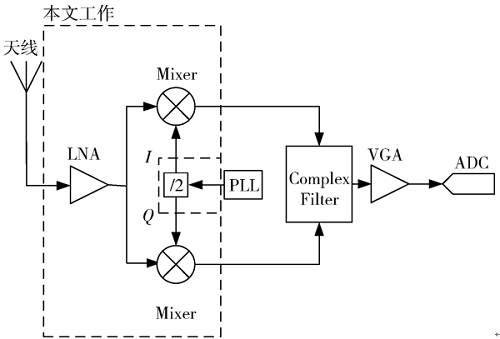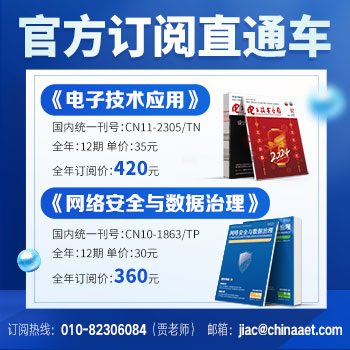一種應用于GNSS射頻接收機的高增益、低噪聲LNA+Mixer
電子技術應用
楊賢成,熊娟
湖北大學 微電子學院
摘要: 提出了一種基于標準0.18 μm 互補金屬氧化物半導體(Complementary Metal Oxide Semiconductor, CMOS)工藝的射頻前端集成電路設計方案,針對全球定位系統(Global Positioning System, GPS)L1和北斗B1雙模導航系統的應用需求,提升了低噪聲放大器(Low-Noise Amplifier, LNA)與下變頻混頻器的關鍵性能指標。在電路架構方面,針對低噪聲放大器,創新性地采用感應源退化技術,通過外部電容與柵源電容并聯有效降低了噪聲系數;而對于下變頻混頻器模塊,則選用了具有結構優勢的無源單平衡拓撲,在保證轉換增益的同時顯著改善了線性度指標并降低了1/f噪聲干擾。測試結果顯示,該方案在1.8 V電壓下實現60 dB鏈路增益和2 dB噪聲系數,整體功耗僅22 mW。系統集成測試中,當輸入功率為-100 dBm時,輸出中頻功率達3.15 dBm。
中圖分類號:TN432 文獻標志碼:A DOI: 10.16157/j.issn.0258-7998.256643
中文引用格式: 楊賢成,熊娟. 一種應用于GNSS射頻接收機的高增益、低噪聲LNA+Mixer[J]. 電子技術應用,2025,51(11):59-64.
英文引用格式: Yang Xiancheng,Xiong Juan. A high-gain, low-noise LNA and mixer for GNSS RF receivers[J]. Application of Electronic Technique,2025,51(11):59-64.
中文引用格式: 楊賢成,熊娟. 一種應用于GNSS射頻接收機的高增益、低噪聲LNA+Mixer[J]. 電子技術應用,2025,51(11):59-64.
英文引用格式: Yang Xiancheng,Xiong Juan. A high-gain, low-noise LNA and mixer for GNSS RF receivers[J]. Application of Electronic Technique,2025,51(11):59-64.
A high-gain, low-noise LNA and mixer for GNSS RF receivers
Yang Xiancheng,Xiong Juan
School of Microelectronics, Hubei University
Abstract: This paper presents a radio frequency front-end integrated circuit design based on a standard 0.18 μm CMOS process, specifically tailored for dual-mode navigation systems supporting GPS L1 and Beidou B1. The design emphasizes optimized key performance metrics for both the low-noise amplifier (LNA) and down-conversion mixer. For the LNA architecture, this study innovatively employs an inductive source degeneration technique, effectively reducing the noise figure by connecting external capacitors in parallel with gate source capacitors. Regarding the down-conversion mixer module, a structurally advantageous passive single-balanced topology is adopted, significantly improving linearity metrics and suppressing 1/f noise interference while maintaining conversion gain. The test results show that the scheme achieves a 60 dB link gain and a 2 dB noise figure at a voltage of 1.8 V, with an overall power consumption of only 22 mW. In the system integration test, when the input power is -100 dBm, the output intermediate frequency power reaches 3.15 dBm.
Key words : GPS/Beidou;low-noise amplifier;mixer;0.18 μm CMOS process
引言
全球導航衛星系統(GNSS)作為現代定位技術的核心,憑借其全天候、高精度的特性,在軍民領域均展現出不可替代的價值。其中,GPS L1與北斗B1頻段如表1所示,因覆蓋范圍廣、信號穩定性強,成為雙模接收機設計的重點。然而,雙系統協同工作對射頻前端提出了嚴苛要求:需在相鄰頻點(僅間隔約14 MHz)實現低噪聲、高增益的信號接收,同時兼顧低功耗與高線性度。
表1 GPS L1和BD B1信號特征

現有研究中,多頻段接收機常采用寬帶低噪聲放大器(LNA)或可調諧LNA方案[1-3],但此類設計易因帶寬擴展引入額外噪聲,并增加芯片面積與功耗。此外,傳統混頻器在1/f噪聲與線性度間的權衡限制了整體性能提升。針對上述挑戰,本文提出一種基于0.18 μm CMOS工藝的窄帶集成LNA+混頻器方案,如圖1所示。LNA采用感應源退化技術,通過優化輸入匹配網絡與級聯結構,顯著降低噪聲系數(NF)[4];混頻器則選用無源單平衡拓撲,結合占空比優化的本振信號與跨阻放大器(TIA),在抑制1/f噪聲的同時提升轉換增益。

圖1 GNSS接收機
仿真結果表明,所設計電路在GPS L1/北斗B1雙頻點下實現了60 dB的總增益、2 dB的噪聲系數及-24 dBm/-26 dBm的輸入三階交調點(IIP3),整體功耗僅為22 mW。與同類研究相比,本方案在鄰近頻點兼容性、噪聲-功耗均衡性等方面具有顯著優勢,為高精度雙模導航接收機提供了可靠的射頻前端解決方案。
本文詳細內容請下載:
http://m.jysgc.com/resource/share/2000006841
作者信息:
楊賢成,熊娟
(湖北大學 微電子學院,湖北 武漢 430072)

此內容為AET網站原創,未經授權禁止轉載。

